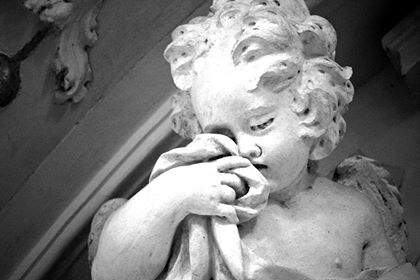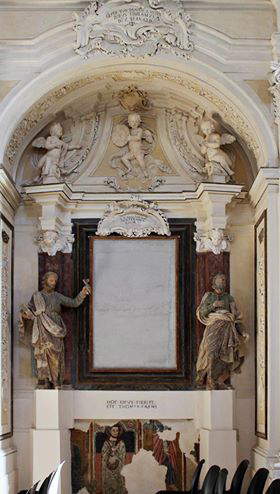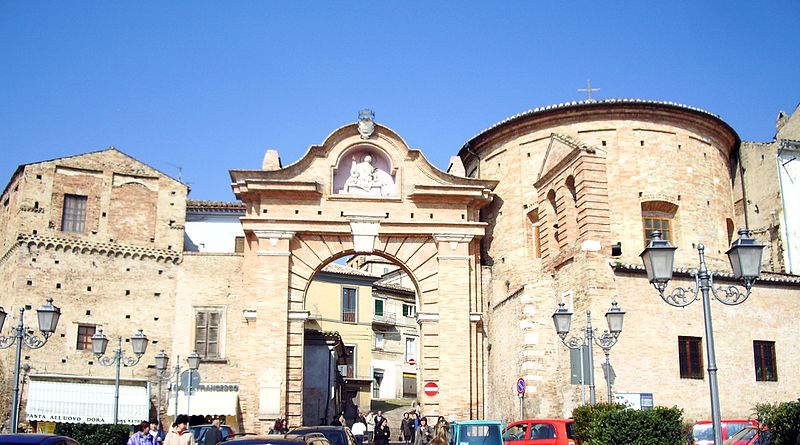A victim of political inability: the city of Penne in Abruzzo and its cultural heritage
Open for a half-day after eight years: this is the summary of the sad contemporary history of Santa Maria Assunta in Colleromano, a precious medieval monastic complex on the outskirts of the city of Penne (Pescara). On Saturday, September 2, by the local FAI section, it was exceptionally opened.
The church, unusable since 2009, could only be glimpsed by looking out of the portal, the work of Raimondo del Poggio, one of the protagonists of Abruzzo sculpture between the 13th and 14th centuries. One immediately noticed the sand of rubble on the floor and the bricks laid bare on the crosses, indications of deeper cracks. From the fleeting observation made, the monumental wooden high altar, erected in the late 500s and early 600s, appeared to be in good condition, with canvases by Aert Mytens, a Flemish painter very active in central-southern Italy, in Rome (where he died in 1602), Naples, LAquila and Penne. Barely glimpsed are the side altars, the result of an early 1700s renovation by Giovan Battista Gianni of Como, which, however, reuse earlier altarpieces and frescoes, such as the late 16th-century copy of Raphael’s Visitation at the Prado, then a must-have of the artistic education of Abruzzese patrons and painters being the loriginal one inAquila.
By contrast, the adjoining convent, first Benedictine and since 500 Franciscan, is habitable, but its fate is perhaps even sadder: left few in number and sent in 2011 to the convent in Lanciano (Chieti), the friars gave the entire complex to the municipality, which, however, to date has not initiated plans for its recovery and enhancement. The total abandonment is prevented only by the San Cesidio Giacomantonio Association, founded in 2004, which still takes care of the complex and makes it available to scholars (I thank Dr. Paolo Di Simone, art historian, for the report).
Thus the small museum that the friars have put up since the 1970s is not normally open to visitors, albeit with a somewhat elementary set-up, somewhere between a depository and a chamber of wonders: in a vast hall are paintings from the church’s decommissioned altars, goldsmithing, vestments, figurines and statues dressed for the personal devotion of the religious, ceramic fragments, and objects brought back by the friars on missions to China, Japan and Palestine. The closure of the convent meant another unresolved problem for the museum: the friars claimed ownership of a few objects, taken, brought and displayed in Lanciano, such as two reliquary busts from the 1500s, of which empty shelves with captions remain in Penne; and if much is still left on site, it is still due to the San Cesidio Association.
Colleromano is now closed again. Who knows when the restorations will take place, who knows when the final reopening will take place. It is not part of any project of the Superintendence, nor of the interventions of the Masterplan drawn up a few months ago by the Region. Moreover, only two buildings in Penne are part of any restoration project, the Cathedral and the Church of the Annunziata, which did not have considerable injuries in the earthquake events of recent years and in fact are among the few monuments that can be visited in the center.
Penne has been languishing since 2009. Perhaps, among the historically significant centers affected then, it is the only one that follows a downward rather than an upward parabola. There have been no collapses and no evacuees, but the proximity to the eastern sector of the Gran Sasso has made the tremor well felt and caused numerous and serious uninhabitations. Little has been done and the latest sad events have made the situation worse.
 |
| Detail of one of the stuccoes of St. John the Baptist. Ph. Credit Gioele Scordella |
The list of what is visitable today is a bit sparse considering the town’s cultural value: the Cathedral, the archaeological museum, the churches of the Annunziata, Carmine, San Giovanni Evangelista, San Nicola, San Ciro, Santa Croce and San Panfilo (not all of which are easily opened). Closed is SantAgostino, a Baroque church with important traces of late 300s-early 400s fresco decoration(here an article by Paolo Di Simone on the frescoes); closed is the Diocesan Museum, a true visual sage of local artistic history; closed is the church of San Domenico; re-closed is Santa Chiara, restored a few years after the L’Aquila earthquake. Scandalous is the situation of abandonment of no less than three churches, however, pre-dating the earthquake: St. Anthony of Padua, ambitious private chapel of the Aliprandi family; St. Mary of the Belt, not long since broken through and robbed of paintings despite repeated appeals to the Superintendency (the two galleries made in 2009 and 2012 well highlight the rapid deterioration. We learn that what remains of the statue of the Madonna has been saved); but above all St. John the Baptist, Abruzzo’s only monastery of the Dames of Malta, one of the region’s most representative Baroque buildings, closed since 1975: the windows are smashed, the roof threatens to collapse and let water through in several places, grass grows among the cherubs and saints of the altars (but the paintings are safe at the closed Diocesan Museum). Photos of the exterior and interior of St. John the Baptist here.
Penne, population about 12,000, has a remarkable past. Of Roman origin, the seat of one of the oldest and richest dioceses inAbruzzo, the home of a lavish aristocracy that constituted the ruling class, the city as a whole was a small court,able to accommodate and converse with its feudal lords: above all one recalls Margaret of Austria, who received Penne as a dowry from her father, Charles V.
 |
| One of the Baroque altars of the Collegiate Church of Colle Castello. Ph. Credit Gioele Scordella |
The city, set on two steep hills, Sacro and Castello, crossed by steep, narrow and winding streets, took advantage of what could have been trouble spots to create urban settings that satisfied the representational needs of the nobility, especially in the 1700s, looking to the most up-to-date Baroque solutions: churches and palaces rise with elaborate facades at the most unpredictable points, so narrow that the only observation possible is from below up. Emblematic is the perspective telescope, resolved in a small square, between Porta San Francesco, a true triumphal entrance, and the Palazzo Castiglioni (now propped up), with lardita and high loggia on two orders, late Baroque works by the Neapolitan Francesco Di Sio. But the whole city is an emotional journey, where buildings of all eras interlock and meet without warning, now Gothic arches walled into houses from the 1500s, now Art Nouveau signs on a Baroque palace, now medieval frescoes under the 18th-century altars of the Collegiata di Colle Castello. From an artistic point of view, what emerges is an interesting and original figurative civilization, made up of local and foreign authors transferred, capable of satisfying commissions from all over the diocese and sometimes even beyond, whose names and testimonies remain especially for the period between the late 16th and 19th centuries: Giambattista and Francesco Ragazzini of Ravenna, Leonzio Compassino, Francesco Salvatori, Domiziano Vallarola, Giuseppangelo Ronzi, Aniello Francia, just to make a mere list of a few names. In the 1800s Penne was still the second largest center in the province of Teramo.
 |
| Penne, Porta San Francesco with Palazzo Castiglioni in the background. Ph. Credit |
The coup de grace came in 1927, when Pescara with its province was born: the Penne territory was among those that became part of it. Guido Piovene, in his Viaggio in Italia (Journey in Italy), already in the 1950s called Pescara an American city, a miracle of theItaly of the time, where so many Abruzzese flocked in search of work and well-being. Pescara, a new city, has built its identity by absorbing different identities, it has received without ever giving, it has accelerated the process of displacement of population, work, culture along the coast that still characterizes theAbruzzo, its metropolitan area is the only regional area that has a constant and serious population growth. All of this is amplified in the territory under its direct jurisdiction: one can imagine how devastating are the effects of cuts in health, culture and administration, which tend to concentrate almost everything in the major centers, in a largely mountainous and hilly province that has its capital in the narrow piece of coastline where Pescara is crowded.
One does not want to condemn a historic change, but one wonders if those in charge could not pay some attention outside the few square (but too densely populated) kilometers of Pescara, the Greater Pescara, whose own citizens hatch dreams of a metropolis and are in favor of taking the dAbruzzo capital away fromAquila. Such proposals were heard as early as a few days after April 6, 2009; and on Facebook there is a nice group of provincialites called Pescara capoluogo di regione (it should be specified that the writer does not speak out of L’Aquila pride, since he was born and raised near Pescara in a family equally rooted in the area).
The mountains empty out; the great tragedy of this winter’s heavy snowfall, the Rigopiano avalanche, occurred just a few kilometers from Penne, which became the sudden base for rescue operations that had to deal with the depletion of the local hospital: the injured and dead had to be taken to the other end of the province, to Pescara. The master plan mentioned earlier, intended to help mainly the crater (of which Penne is part and is one of the largest centers, more populous than destroyed localities such as Norcia and Camerino), also sees some not very relevant buildings in the coastal localities and too many, if one counts the initial idea, monuments in Pescara. It was preferred to restore Pescara’s Santuario dell’Addolorata, a modest nineteenth-century church to which great devotional attachment is nevertheless to be credited, instead of San Panfilo fuori le mura, a real church in the form of a theater because of its Baroque setting located in Spoltore, a quarter-hour from Pescara, where mass is said under frescoed vaults furrowed by conspicuous cracks.
There is a bit of a stench to smell of politics: the current president of Abruzzo has long been the head of Pescara’s municipality and province. Penne is in danger of losing its identity, starting from the very awareness that citizens have to that of the surrounding territories. Just outside its valley Penne is perceived by the population as an anonymous place, where there is nothing interesting or almost nothing. Visiting Penne today brings the mind, with due differences, to cities like Venice and Naples that have lost their role and suffer from a second or third-rate place that is reflected in the demographic, psychological, and conservative neglect of historic centers. Abruzzo has failed to exploit a characteristic typical of many Italian regions, the coexistence of sea and mountains, but here enhanced by the location in the one and the other of the two main centers, Pescara and LAquila: instead, no, everything must be brought to Pescara, even the bishop since the 1980s has been in Pescara, Penne is only a secondary seat. The mountains become a toyland, an idealized place enclosed in an Edenic and false past constructed ad hoc by coastal administrators, where people go for the healthy air and good food. Once the fun is over, it’s back to the city. Heaven forbid to take the inland areas seriously. Besides, the rides are taken care of by the owners, that is, their inhabitants: few and now psychologically affected in their identity.
Basic bibliography to delve into the historical-artistic aspects of the city of Penne:
- Luisa Franchi dellOrto (ed.), Documenti dellAbruzzo Teramano, Vol. VI: Dalla valle del Fino alla valle del medio e alto Pescara, Fondazione Cassa di Risparmio della Provincia di Teramo Tercas spa, 2003
Warning: the translation into English of the original Italian article was created using automatic tools. We undertake to review all articles, but we do not guarantee the total absence of inaccuracies in the translation due to the program. You can find the original by clicking on the ITA button. If you find any mistake,please contact us.



























